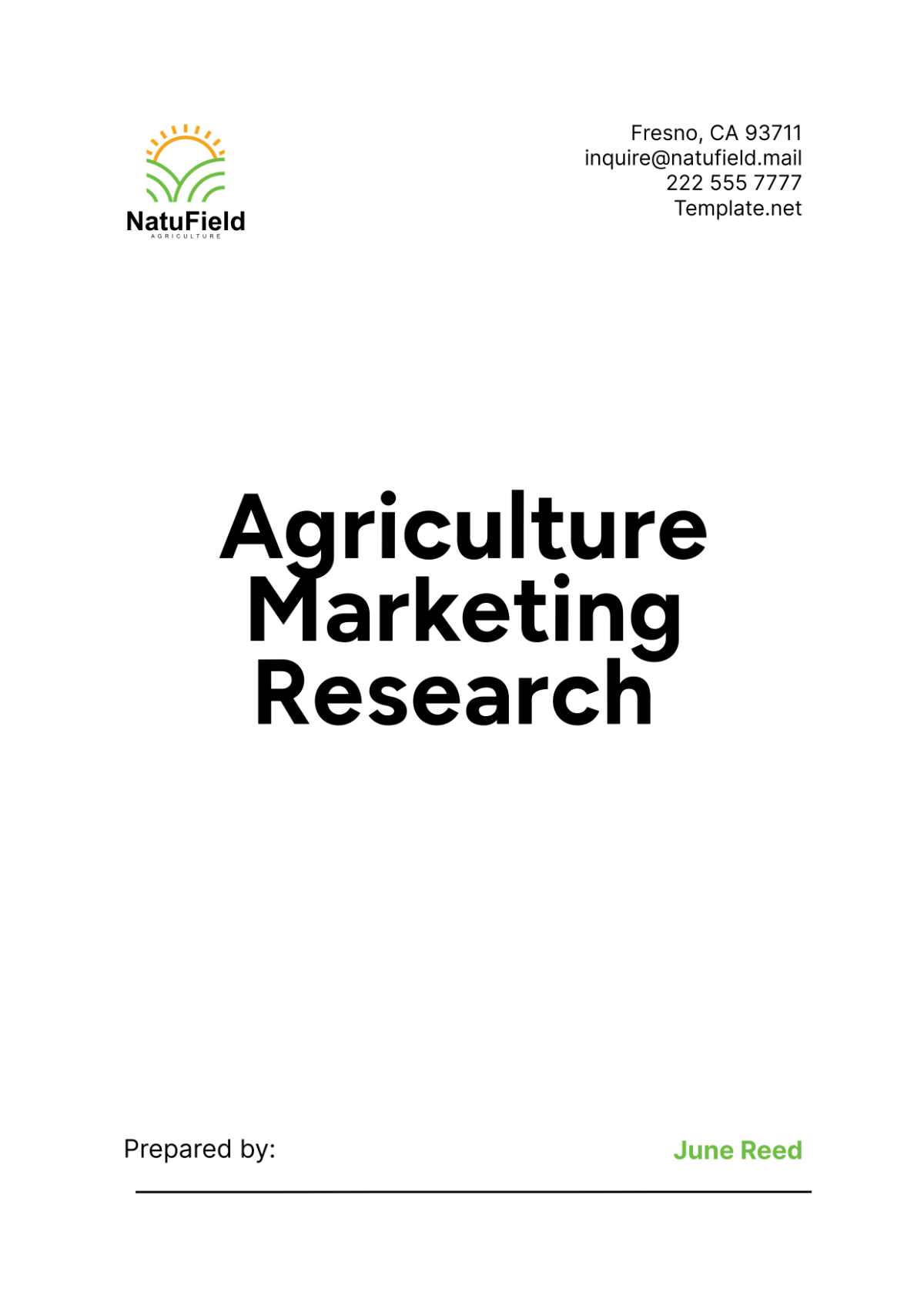Free Agriculture Marketing Research

Introduction
Marketing research is a critical component of strategic planning for agricultural businesses. This comprehensive research report aims to provide [Your Company Name] with actionable insights into market trends, customer behavior, competitive landscape, and opportunities for growth. By leveraging these insights, we can develop effective marketing strategies to enhance our market presence and drive sustainable growth.
1. Market Overview
Understanding the current market landscape is essential for identifying opportunities and challenges. This chapter provides a detailed analysis of the agricultural market, including size, growth rate, and key trends.
Market Size and Growth
The agricultural market has experienced significant growth over the past decade, driven by increasing global demand for food and sustainable farming practices. In 2050, the market size is estimated to be $500 billion, reflecting a robust annual growth rate of 7%. This expansion is attributed to several factors, including population growth, urbanization, and rising incomes, which have collectively boosted the demand for agricultural products. The market's growth is also supported by advancements in agricultural technology and practices, such as precision farming, which have improved productivity and efficiency.
Key Market Trends
Several key trends are shaping the agricultural market:
Sustainability: There is a growing consumer demand for sustainable and environmentally friendly products. This trend is driven by increased awareness of climate change and environmental degradation, prompting consumers to seek out products that are produced using sustainable methods.
Technology Integration: The adoption of advanced technologies such as precision agriculture, drones, and the Internet of Things (IoT) is revolutionizing the agricultural sector. These technologies enhance productivity, reduce waste, and improve the overall efficiency of farming operations.
Organic Products: There is a significant shift towards organic and non-GMO products, as consumers become more health-conscious and concerned about the impact of chemicals and genetically modified organisms on their health.
Global Expansion: The agricultural market is expanding into emerging markets, where rising disposable incomes and changing dietary habits are creating new opportunities for growth. Countries in Asia, Africa, and Latin America are becoming increasingly important markets for agricultural products.
Competitive Landscape
The competitive landscape of the agricultural market is dynamic, with several key players vying for market share. Major competitors include established firms that have strong brand recognition and extensive distribution networks. However, there is also a growing number of innovative startups that are leveraging technology to disrupt traditional farming practices and capture market share. Understanding the strengths and weaknesses of these competitors is crucial for [Your Company Name] to develop effective strategies and maintain a competitive edge.
1.1 Market Size and Growth
The agricultural market has seen significant growth over the past decade. In 2050, the market size is estimated to be $500 billion, with an annual growth rate of 7%. This growth is driven by increasing demand for sustainable and organic products, advancements in agricultural technology, and expanding global markets.
Table: Market Size and Growth
Year | Market Size ($ Billion) | Growth Rate (%) |
|---|---|---|
2046 | 350 | 5% |
2047 | 370 | 6% |
2048 | 400 | 8% |
2049 | 450 | 10% |
2050 | 500 | 7% |
1.2 Key Market Trends
Several key trends are shaping the agricultural market:
Sustainability: Increasing consumer demand for sustainable and environmentally friendly products.
Technology Integration: Adoption of advanced technologies such as precision agriculture, drones, and IoT.
Organic Products: Growing preference for organic and non-GMO products.
Global Expansion: Expansion into emerging markets with rising disposable incomes and changing dietary habits.
2. Customer Analysis
A thorough understanding of customer demographics, preferences, and behaviors is crucial for developing targeted marketing strategies. This chapter explores these aspects in detail.
2.1 Demographics
The primary customer base for agricultural products includes individuals aged 25-50, predominantly residing in urban and suburban areas with middle to high income levels.
Table: Customer Demographics
Demographic | Percentage (%) |
|---|---|
Age 25-35 | 30 |
Age 36-50 | 40 |
Urban Residents | 60 |
Suburban Residents | 30 |
Rural Residents | 10 |
Middle Income | 50 |
High Income | 40 |
2.2 Customer Preferences
Customers are increasingly prioritizing the following attributes in their purchasing decisions:
Organic and Non-GMO Products: 70% of customers prefer organic and non-GMO products.
Sustainability: 65% of customers are willing to pay a premium for sustainably produced goods.
Local Sourcing: 55% of customers prefer locally sourced products to support local economies and reduce carbon footprints.
2.3 Buying Behavior
Understanding buying behavior helps in tailoring marketing efforts to meet customer needs:
Frequent Purchases: Customers tend to make frequent purchases, especially for perishable goods like fruits, vegetables, and dairy products.
Digital Channels: 50% of purchases are made through online platforms, indicating a significant shift towards e-commerce.
Brand Loyalty: 40% of customers exhibit high brand loyalty, consistently choosing brands that align with their values.
3. Competitive Analysis
Analyzing the competitive landscape allows us to identify our strengths and weaknesses relative to key competitors. This chapter provides an overview of major competitors and their market positions.
3.1 Competitor Overview
Major competitors in the agricultural market include [Competitor A], [Competitor B], and [Competitor C]. These companies have established strong market positions through various strategies such as brand recognition, pricing, and distribution networks.
3.2 Competitor Strengths and Weaknesses
Table: Competitor Analysis
Competitor | Strengths | Weaknesses |
|---|---|---|
Competitor A | Strong brand recognition | Limited product variety |
Competitor B | Competitive pricing | Low customer loyalty |
Competitor C | Wide distribution network | Higher prices |
3.3 Market Position
[Your Company Name] holds a 10% market share, positioning it as a significant player in the agricultural market. To improve our market position, we need to leverage our strengths in product quality and sustainability while addressing our weaknesses in market presence and distribution.
4. Market Segmentation
Market segmentation involves dividing the market into distinct groups of consumers with similar needs and characteristics. This chapter outlines the segmentation strategy for [Your Company Name].
4.1 Segmentation Criteria
The market can be segmented based on several criteria, including demographics, psychographics, and purchasing behavior.
4.2 Target Segments
Table: Target Market Segments
Segment | Description | Percentage of Market (%) |
|---|---|---|
Health Conscious | Consumers prioritizing health and wellness | 25 |
Eco-Friendly | Consumers focused on sustainability | 20 |
Convenience Seekers | Consumers looking for convenience and ease | 15 |
Budget Shoppers | Price-sensitive consumers | 10 |
Premium Buyers | High-income consumers seeking premium products | 30 |
4.3 Segment Profiles
Health Conscious: Aged 25-45, higher education, willing to pay a premium for health benefits.
Eco-Friendly: Aged 30-50, environmentally aware, prefers sustainable products.
Convenience Seekers: Aged 20-40, busy lifestyle, values quick and easy solutions.
Budget Shoppers: Aged 18-60, price-sensitive, looks for discounts and value for money.
Premium Buyers: Aged 35-55, high disposable income, seeks quality and exclusivity.
5. Marketing Mix
The marketing mix, or the 4Ps (Product, Price, Place, Promotion), is a crucial framework for developing effective marketing strategies. This chapter outlines [Your Company Name]'s marketing mix for entering the new market.
5.1 Product
Objective: To offer high-quality, sustainable agricultural products that meet customer needs.
Product Strategy:
Variety: Provide a wide range of products, including fruits, vegetables, grains, and dairy.
Quality: Ensure products are organic, non-GMO, and sustainably sourced.
Packaging: Use eco-friendly packaging to appeal to environmentally conscious consumers.
5.2 Price
Objective: To set competitive prices that reflect the value of our products while ensuring profitability.
Pricing Strategy:
Competitive Pricing: Price products competitively to attract price-sensitive customers.
Premium Pricing: Set higher prices for premium products to target high-income consumers.
Discounts and Promotions: Offer discounts and promotions to drive sales and increase customer loyalty.
Table: Pricing Strategy
Product Category | Base Price ($) | Discount (%) | Promotional Price ($) |
|---|---|---|---|
Fruits | 40 | 10 | 36 |
Vegetables | 35 | 15 | 29.75 |
Grains | 30 | 5 | 28.50 |
Dairy | 50 | 20 | 40 |
5.3 Place
Objective: To ensure products are readily available to customers through various distribution channels.
Distribution Strategy:
Retail Stores: Partner with local retailers to reach a broad customer base.
Online Sales: Utilize e-commerce platforms to cater to the growing number of online shoppers.
Direct Sales: Implement direct sales strategies such as farmers' markets and subscription services.
5.4 Promotion
Objective: To create awareness and generate demand for our products through targeted promotional activities.
Promotional Strategy:
Advertising: Utilize digital and traditional advertising channels to reach potential customers.
Social Media Marketing: Engage with customers through social media platforms to build brand loyalty.
Public Relations: Leverage PR efforts to enhance brand reputation and visibility.
Table: Promotional Budget Allocation
Channel | Budget ($) | Percentage of Total |
|---|---|---|
Digital Advertising | 100,000 | 40% |
Traditional Advertising | 50,000 | 20% |
Social Media Marketing | 75,000 | 30% |
Public Relations | 25,000 | 10% |
Total | 250,000 | 100% |
6. Sales Strategy
An effective sales strategy is essential for achieving revenue targets and market penetration. This chapter outlines the sales strategy for [Your Company Name].
6.1 Sales Objectives
Objective: To set clear and achievable sales targets.
Goals:
Revenue Target: Achieve $2,000,000 in sales revenue within the first year.
Market Share: Capture 10% market share within two years.
Customer Acquisition: Acquire 10,000 new customers within the first year.
6.2 Sales Channels
Objective: To utilize multiple sales channels to reach a diverse customer base.
Sales Channels:
Direct Sales: Employ a direct sales force to engage with large buyers and institutional clients.
Retail Partnerships: Establish partnerships with retail chains and specialty stores.
E-commerce: Leverage online sales platforms to reach tech-savvy consumers.
6.3 Sales Tactics
Objective: To implement effective sales tactics that drive customer acquisition and retention.
Tactics:
Product Demonstrations: Conduct product demonstrations at farmers' markets and trade shows.
Loyalty Programs: Implement loyalty programs to reward repeat customers.
Sales Promotions: Offer time-limited promotions to encourage immediate purchases.
Table: Sales Tactics and Budget
Tactic | Budget ($) | Expected Outcome |
|---|---|---|
Product Demonstrations | 50,000 | Increased brand awareness and sales |
Loyalty Programs | 30,000 | Higher customer retention |
Sales Promotions | 20,000 | Short-term sales boost |
Total | 100,000 |
7. Financial Projections
Financial projections provide a roadmap for expected revenue, expenses, and profitability. This chapter presents detailed financial forecasts for the first three years.
7.1 Revenue Projections
Objective: To forecast revenue based on market analysis and sales targets.
Table: Revenue Projections
Year | Revenue ($) |
|---|---|
Year 1 | 2,000,000 |
Year 2 | 3,000,000 |
Year 3 | 4,000,000 |
7.2 Expense Projections
Objective: To forecast expenses based on operational and marketing plans.
Table: Expense Projections
Year | Production Costs ($) | Marketing Costs ($) | Operational Costs ($) | Total Expenses ($) |
|---|---|---|---|---|
Year 1 | 1,000,000 | 250,000 | 500,000 | 1,750,000 |
Year 2 | 1,500,000 | 300,000 | 600,000 | 2,400,000 |
Year 3 | 2,000,000 | 350,000 | 700,000 | 3,050,000 |
7.3 Profit and Loss Projections
Objective: To forecast profitability based on revenue and expense projections.
Table: Profit and Loss Projections
Year | Revenue ($) | Total Expenses ($) | Net Profit ($) |
|---|---|---|---|
Year 1 | 2,000,000 | 1,750,000 | 250,000 |
Year 2 | 3,000,000 | 2,400,000 | 600,000 |
Year 3 | 4,000,000 | 3,050,000 | 950,000 |
7.4 Break-Even Analysis
Objective: To determine the break-even point for market entry.
Table: Break-Even Analysis
Year | Fixed Costs ($) | Variable Costs ($) | Break-Even Point (Units) |
|---|---|---|---|
Year 1 | 500,000 | 10 | 50,000 |
Year 2 | 500,000 | 10 | 50,000 |
Year 3 | 500,000 | 10 | 50,000 |
8. Risk Management
Effective risk management is crucial for mitigating potential challenges in market entry. This chapter outlines the key risks and mitigation strategies.
8.1 Market Risks
Objective: To identify and mitigate risks associated with market conditions.
Risks:
Economic Instability: Impact on consumer purchasing power.
Competitive Pressure: Aggressive competition from established players.
Mitigation Strategies:
Economic Instability: Diversify product offerings and target different customer segments.
Competitive Pressure: Differentiate products through quality, innovation, and customer service.
8.2 Operational Risks
Objective: To identify and mitigate risks associated with operational activities.
Risks:
Supply Chain Disruptions: Potential delays or interruptions in the supply chain.
Quality Control Issues: Risk of product quality not meeting standards.
Mitigation Strategies:
Supply Chain Disruptions: Establish multiple suppliers and develop contingency plans.
Quality Control Issues: Implement strict quality control measures and regular inspections.
8.3 Financial Risks
Objective: To identify and mitigate financial risks.
Risks:
Currency Fluctuations: Impact on profitability due to exchange rate changes.
Funding Shortfalls: Insufficient funds to support market entry activities.
Mitigation Strategies:
Currency Fluctuations: Use hedging strategies to manage exchange rate risk.
Funding Shortfalls: Secure multiple funding sources and maintain a contingency fund.
8.4 Compliance Risks
Objective: To identify and mitigate risks associated with regulatory compliance.
Risks:
Regulatory Changes: Potential changes in import/export regulations.
Non-Compliance: Risk of non-compliance with local laws and regulations.
Mitigation Strategies:
Regulatory Changes: Stay informed about regulatory developments and adjust strategies accordingly.
Non-Compliance: Implement robust compliance programs and conduct regular audits.
Table: Risk Management Plan
Risk | Impact | Likelihood | Mitigation Strategy |
|---|---|---|---|
Economic Instability | High | Medium | Diversify product offerings |
Competitive Pressure | Medium | High | Differentiate products |
Supply Chain Disruptions | High | Medium | Multiple suppliers, contingency plans |
Quality Control Issues | Medium | Low | Strict quality control measures |
Currency Fluctuations | High | High | Hedging strategies |
Funding Shortfalls | High | Low | Secure multiple funding sources |
Regulatory Changes | Medium | Medium | Stay informed, adjust strategies |
Non-Compliance | High | Low | Robust compliance programs, regular audits |
Conclusion
The Agriculture Marketing Research report for [Your Company Name] provides a comprehensive analysis of the market landscape, customer behavior, competitive environment, and strategic opportunities. By leveraging these insights, we can develop effective marketing strategies to enhance our market presence, drive sustainable growth, and achieve our business objectives. The detailed financial projections and risk management plans outlined in this report will guide our efforts to ensure successful market entry and long-term profitability.
- 100% Customizable, free editor
- Access 1 Million+ Templates, photo’s & graphics
- Download or share as a template
- Click and replace photos, graphics, text, backgrounds
- Resize, crop, AI write & more
- Access advanced editor
Enhance your market insights with Template.net's Agriculture Marketing Research Template. Ideal for the agricultural sector, this template is fully editable and customizable with our AI editor. It provides a structured framework to gather and analyze market data, helping you understand customer preferences, competitive landscapes, and emerging trends to make informed marketing decisions.





























